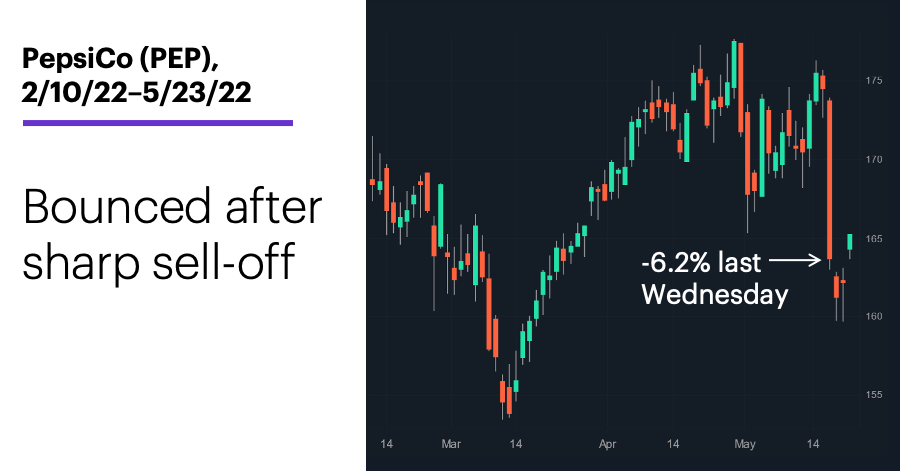Synthesizing a long trade
- PEP bounced Monday after steep drop last week
- Stock has outperformed broad market this year
- “Synthetic” stock position an alternative for some short-term traders?
Last week’s stock sell-off left few areas of the market untouched. For example, while it’s outperformed the broad market this year, PepsiCo (PEP) pulled back sharply, especially on May 18:

Source: Power E*TRADE. (For illustrative purposes. Not a recommendation.)
It was certainly a bad day for PEP—its biggest one-day loss since March 2020, and one of only 60 days since 1972 that the stock fell 5% or more. Of course, last Wednesday was also the worst day for the S&P 500 (SPX) in nearly two years, so PEP was hardly an isolated case. The potential upside for PEP bulls: Two weeks after its 5%-or-larger declines, PEP was higher 65% of the time, with an average gain of 2.8%.1 (The stock gained more than 2% yesterday.)
Options traders who may have thought stocks like PEP could rebound in the near term, especially in the event of a broader market bounce, faced a range of choices. While the most conservative traders may have thought about buying calls, those recognizing the recent sell-off had inflated volatility levels—and, by association, options prices—may have leaned toward a position like the bull call spread. Unlike a long call, the bull spread has limited upside, but it can benefit from high volatility and time decay because it contains a short call. (On Monday, PEP’s options implied volatility was near its highest levels since November 2020.)
The “synthetic stock” strategy occupies the other end of the risk spectrum, but it has one thing in common with the bull call spread: It contains a long option and a short option, so it also has a component that can capitalize on high volatility and the passing of time.
The synthetic isn’t “better” than a stock position, but it can be useful if it complements a trader’s market forecast and risk tolerance.
A long synthetic position consists of a long at-the-money (ATM) call and a short ATM put with the same expiration. While its dollar gain or loss will closely mirror a stock position, the synthetic is less expensive to establish: Margin is typically half that of a stock trade, sometimes less—something that can make the synthetic attractive for shorter-term traders, especially in higher-priced stocks that require more margin.
For example, if you needed $20,000 to buy a certain stock but only $10,000 for the synthetic long, and your dollar profit from either trade was $2,000, the rate of return (ROR) for the stock position would be 10% ($2,000÷$20,000), while the synthetic’s ROR would be 20% ($2,000÷$10,000). But if the trade went against you, the synthetic position’s loss as a percentage of margin would be twice as large as the stock position’s loss.
Most of the time, a synthetic can be executed at no cost or a small credit or debit. Yesterday morning, for example, when PEP was trading a little above $165, the June 10 $165 synthetic could have been established at a small credit (buying the call at 3.30 and selling the put at 3.75):

Source: Power E*TRADE. (For illustrative purposes. Not a recommendation.)
The synthetic long isn’t “better” than buying stock, buying a bull call spread, or using some other strategy, but it can be useful in the right situation—as always, if it fits a trader’s market forecast and risk tolerance.
Today’s numbers include (all times ET): PMI Composite Flash (9:45 a.m.), New Home Sales (10 a.m.).
Today’s earnings include: Canadian Solar (CSIQ), Best Buy (BBY), Ralph Lauren (RL), Toll Brothers (TOL), Agilent Technologies (A), Nordstrom (JWN), Intuit (INTU), Urban Outfitters (URBN).
Click here to log on to your account or learn more about E*TRADE's trading platforms, or follow the Company on Twitter, @ETRADE, for useful trading and investing insights.
1 Figures reflect PepsiCo (PEP) daily closing prices, 6/1/72–5/23/22. Supporting document available upon request.